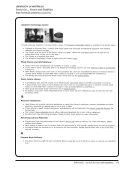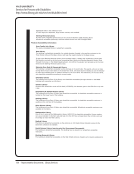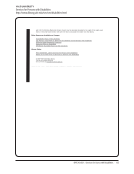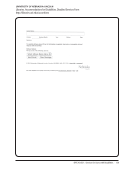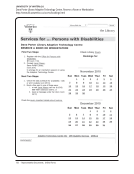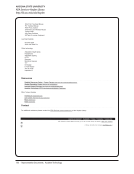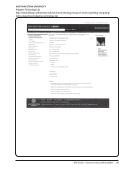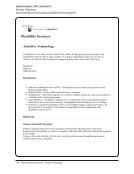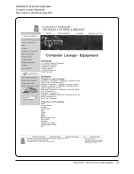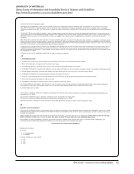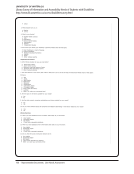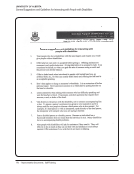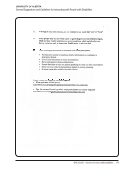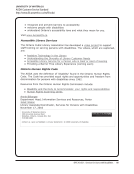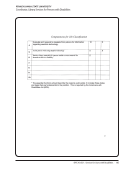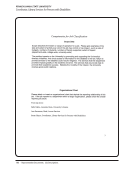SPEC Kit 321: Services for Users with Disabilities · 13
Only one library has vocal labels for the keyboard,
and one other has light signals for computer sounds.
Desktop video magnifiers and CCTV units for the
visually impaired are available at a majority of the re-
sponding libraries. Three libraries have at least small
pocket or portable magnifiers. In the open comments,
fifteen respondents reported the availability of some
kind of Braille equipment: raised, tactile keyboards,
Braille printers, Braille embossers, and Braillers
(typewriters). Two libraries mentioned videophones
for sign language. Others noted talking calculators,
desktop illuminated magnifiers, and talking book
players, including the discontinued Kurzweil Reading
Edge machine. Digital voice recorders are provided at
fourteen locations.
Selecting and Publicizing Services
When asked how the library decides which services
and technology to provide for users with disabilities,
the majority reported that they respond to patrons’
requests. At a little more than half of the libraries,
a service coordinator makes recommendations. At
many institutions, a central disabilities office man-
dates which services and technology to provide, and
a significant number of the responding libraries con-
sult or coordinate with that office. About a quarter of
the respondents have received donations for specific
items. Only nine libraries report that they have sur-
veyed their users about their needs.
The three most common methods libraries use
to inform potential users about services are through
the campus disabilities office, the library website, and
word of mouth. Services are also promoted through li-
brary signage, in instruction and orientation sessions,
and through brochures and flyers. A few respondents
have placed articles in either a library newsletter or
campus newspaper.
Coordinating Services
At 18 of the responding institutions, an individual in a
central unit has primary responsibility for coordinat-
ing support services for persons with disabilities. At
another 18 institutions, this responsibility is shared be-
tween the central disabilities coordinator and a library
disabilities coordinator. Thirteen respondents report
that a library disabilities coordinator has primary
responsibility for this role. Ten other libraries report
that another individual or a committee assumes the
service coordination responsibility.
The frequency with which the central coordinator
and library staff interact ranges from infrequently, to
as needed, to often. Most of the respondents indicated
there is regular, on-going contact as often as they feel
is necessary.
The survey asked the libraries that employ an
ADA officer/disabilities coordinator or other desig-
nated person to oversee services for users with dis-
abilities to provide the approximate percentage of
time spent coordinating services. Of the 29 positions
described, only three spend 90% to 100% of their time
on coordinating services. Four devote 30% to 50% of
their time to these activities. For the rest, service co-
ordination accounts for between 1% and 10% of their
work responsibilities.
The survey next asked who has responsibility for
interpreting applicable disabilities laws for library
staff. At all but a few institutions, the central disabili-
ties coordinator has primary responsibility. At many
institutions, this individual shares the responsibil-
ity with the organization’s counsel or legal unit and
the library’s disabilities coordinator. At the other in-
stitutions the responsibility falls primarily on legal
counsel.
Library Service Providers
Responses to a question about which library staff
members are expected to provide services for users
with disabilities overwhelmingly echoed the state-
ment that, “All staff who work on a public services
desk are responsible for assisting users with disabili-
ties.” Or as one respondent commented, “At the mini-
mum, anyone approached should be able to make a
proper referral.”
The primary way that library staff members re-
ceive training about assisting users with disabilities
and how to use the available assistive technology is by
hands-on training from the disabilities coordinator. A
number of respondents report that staff also occasion-
ally attend workshops, webinars, and conferences, or
consult manuals. Twelve libraries reported making
use of vendors or outside consultants for technol-
ogy training as well as tips on helping the users and
Only one library has vocal labels for the keyboard,
and one other has light signals for computer sounds.
Desktop video magnifiers and CCTV units for the
visually impaired are available at a majority of the re-
sponding libraries. Three libraries have at least small
pocket or portable magnifiers. In the open comments,
fifteen respondents reported the availability of some
kind of Braille equipment: raised, tactile keyboards,
Braille printers, Braille embossers, and Braillers
(typewriters). Two libraries mentioned videophones
for sign language. Others noted talking calculators,
desktop illuminated magnifiers, and talking book
players, including the discontinued Kurzweil Reading
Edge machine. Digital voice recorders are provided at
fourteen locations.
Selecting and Publicizing Services
When asked how the library decides which services
and technology to provide for users with disabilities,
the majority reported that they respond to patrons’
requests. At a little more than half of the libraries,
a service coordinator makes recommendations. At
many institutions, a central disabilities office man-
dates which services and technology to provide, and
a significant number of the responding libraries con-
sult or coordinate with that office. About a quarter of
the respondents have received donations for specific
items. Only nine libraries report that they have sur-
veyed their users about their needs.
The three most common methods libraries use
to inform potential users about services are through
the campus disabilities office, the library website, and
word of mouth. Services are also promoted through li-
brary signage, in instruction and orientation sessions,
and through brochures and flyers. A few respondents
have placed articles in either a library newsletter or
campus newspaper.
Coordinating Services
At 18 of the responding institutions, an individual in a
central unit has primary responsibility for coordinat-
ing support services for persons with disabilities. At
another 18 institutions, this responsibility is shared be-
tween the central disabilities coordinator and a library
disabilities coordinator. Thirteen respondents report
that a library disabilities coordinator has primary
responsibility for this role. Ten other libraries report
that another individual or a committee assumes the
service coordination responsibility.
The frequency with which the central coordinator
and library staff interact ranges from infrequently, to
as needed, to often. Most of the respondents indicated
there is regular, on-going contact as often as they feel
is necessary.
The survey asked the libraries that employ an
ADA officer/disabilities coordinator or other desig-
nated person to oversee services for users with dis-
abilities to provide the approximate percentage of
time spent coordinating services. Of the 29 positions
described, only three spend 90% to 100% of their time
on coordinating services. Four devote 30% to 50% of
their time to these activities. For the rest, service co-
ordination accounts for between 1% and 10% of their
work responsibilities.
The survey next asked who has responsibility for
interpreting applicable disabilities laws for library
staff. At all but a few institutions, the central disabili-
ties coordinator has primary responsibility. At many
institutions, this individual shares the responsibil-
ity with the organization’s counsel or legal unit and
the library’s disabilities coordinator. At the other in-
stitutions the responsibility falls primarily on legal
counsel.
Library Service Providers
Responses to a question about which library staff
members are expected to provide services for users
with disabilities overwhelmingly echoed the state-
ment that, “All staff who work on a public services
desk are responsible for assisting users with disabili-
ties.” Or as one respondent commented, “At the mini-
mum, anyone approached should be able to make a
proper referral.”
The primary way that library staff members re-
ceive training about assisting users with disabilities
and how to use the available assistive technology is by
hands-on training from the disabilities coordinator. A
number of respondents report that staff also occasion-
ally attend workshops, webinars, and conferences, or
consult manuals. Twelve libraries reported making
use of vendors or outside consultants for technol-
ogy training as well as tips on helping the users and























































































































